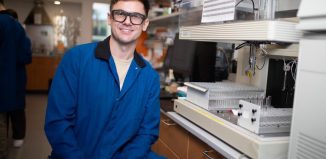CSH researcher Anne Churchland studies rats in a maze
Recent research suggests how the brain puts together multisensory information
Rats are not only capable of learning a maze to get to a reward (the coveted cheese, for example), but they also have the ability to process a combination of slow or fast flashes and clicks to learn whether their prize will be on the left or right side of a cage.
Cold Spring Harbor neuroscientist Anne Churchland recently published a paper in the Journal of Neuroscience that shows that rats are capable of putting together combinations of sights and sounds and changing their behavior to fill their rat stomachs.
The results suggest rats may prove to be effective mammalian models for understanding the neuronal circuitry that other mammals (namely, say, humans) use to process information around them and make decisions about courses of action.
“Very little is known about how the brain puts together multisensory information,” Churchland said. “It’s a mystery how neural circuits of the brain make this happen. An animal model can really get at the neural mechanism that underlies multisensory integration.”
While Churchland’s study was a behavioral one — flash the lights, make the sounds and see where the rat goes — she also plans to add electrophysiological data. That means she will study the neurons that are active as a rat combines pieces of information. Neurons are cells that transmit information through chemical and electrical signals.
By looking closely at the responses of rats, she hopes to figure out how these signals come together.
For some people, reacting to and processing a combination of sights and sounds is sometimes “impaired when compared to typically developing peers,” Churchland explained. Some people, for example, struggle when they go into a multisensory environment, like a grocery store.
“If we understand the sensory side more, we’ll be in a better position to treat those aspects of the disorder,” she explained.
Some people with autism spectrum disorders have a hard time interpreting cues such as a tone of voice, body posture, or the look on someone’s face.
Understanding the sensory side of some of these disorders can put scientists and doctors “in a better position to treat” people, Churchland said.
The Cold Spring Harbor neuroscientist works much more on basic research and is not directly involved in clinical applications.
“I hope that our work might inform the ongoing foundation of knowledge that the community is starting to have about autism spectrum disorders,” she expounded.
Some of Churchland’s passion for addressing autism comes from her experience as a camp counselor and as a babysitter, where she took responsibility for a child with autism. While earning her undergraduate degree at Wellesley College, she took courses in child and cognitive development, even as she was earning a degree in math.
After college, she worked at the University of California at San Francisco, where she “fell in love with lab work,” she recalled. “Doing science captured my imagination. The big questions are so exciting.”
Aside from babysitting and camp, Churchland had plenty of opportunities to think about development and, specifically, neuroscience. Her parents, Anne and Paul Churchland, are neuroscientists and philosophers. Indeed, they met in a philosophy class.
“Their enthusiasm for the field was contagious, not just for me, but it inspired many people,” Churchland said. They addressed questions, she explained, such as, how our brains make us who we are, and how we navigate through the world.
She said her parents didn’t encourage her and her brother Mark to pursue careers in neuroscience.
“When we were undergraduates, NIH [National Institutes of Health] funding was at a low level, as it is now,” she explained.
Still, that didn’t keep either her or her brother Mark away, as both of them have now developed careers in experimental neuroscience.
“I feel really lucky to have a family with so many shared interests,” she said. Some day, she hopes to collaborate with her brother, who works at Columbia University.
As for her immediate family, Churchland is married to Michael Brodesky, who works at Bookish in Manhattan, lives at Cold Spring Harbor, and has two children who are in the early stages of primary school.
In her first experience of living in New York, she lauded Long Island for its hiking and biking trails and kayaking opportunities.






